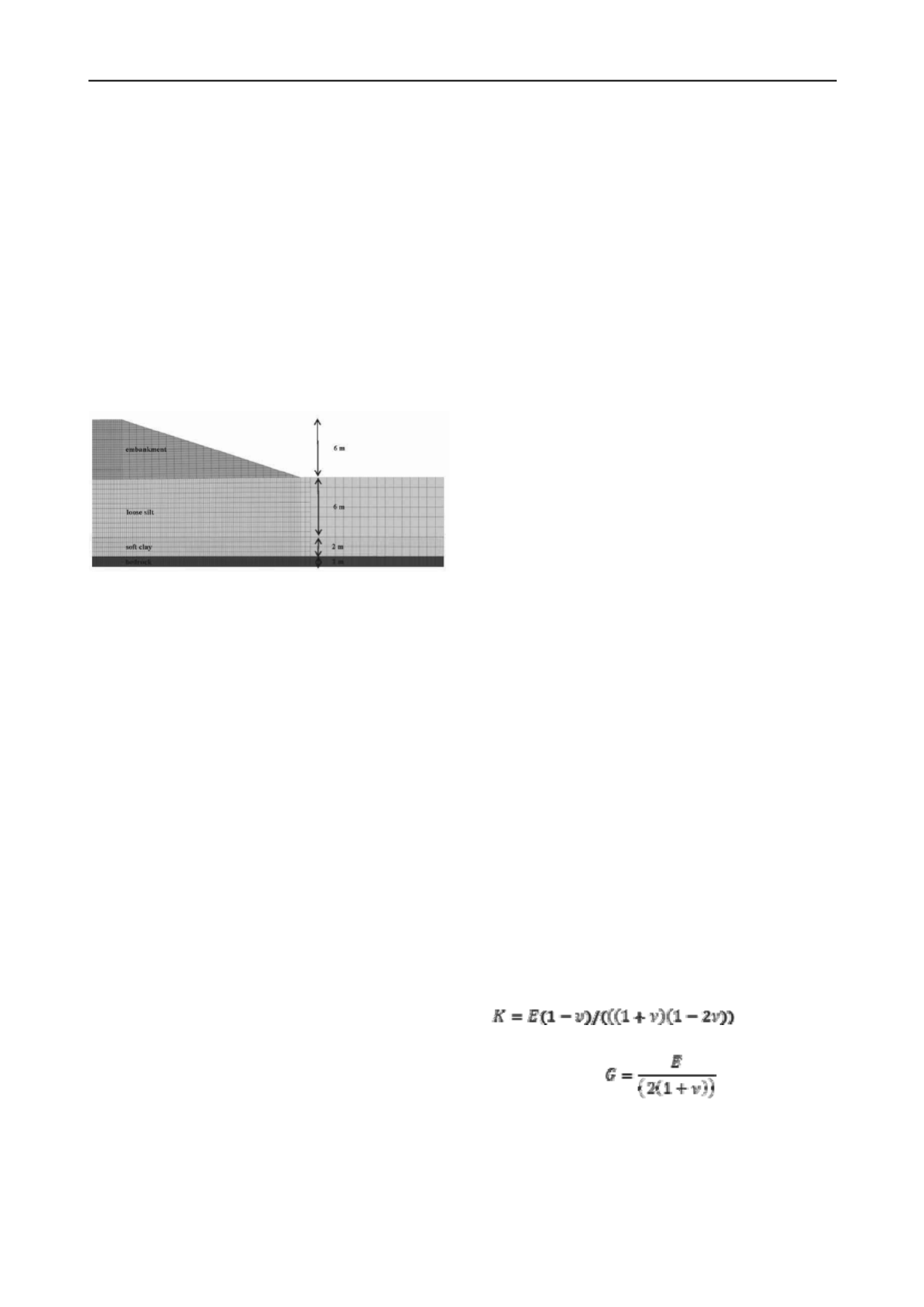
684
Proceedings of the 18
th
International Conference on Soil Mechanics and Geotechnical Engineering, Paris 2013
Material properties were defined based on average values
found in the literature review and are described in greater detail
under the section titled Physical Properties. The groundwater
table was assumed to be located at the surface of the loose silt
deposit. The model was built to maintain a maximum aspect
ratio of 3:1 between elements in the x, y, and z directions and
used planes of symmetry to reduce the total number of elements
in each model. The embankment was constructed in several
phases to simulate more realistic loading conditions.
The groundwater table was modeled using a normal
groundwater force rather than using a groundwater flow model.
This was done to simplify the analyses as the behavior of the
groundwater within the soil was not the focus of the study. As a
result the simplified groundwater conditions the Mohr Coulomb
constitutive model was used to simulate soil response.
Figure 1. Model Stratigraphy
3 METHODS OF GROUND IMPROVEMENTS
3.1 Stone columns
Stone columns, like sand drains, enhance the drainage
properties of soft soils, however, the interlocking granular
nature provides additional shear strength to the surrounding
soils compared to sand drains. Stone columns can be installed as
either independent columns or as continuous walls or panels of
columns. Stone columns reduce settlements by promoting soil
arching which transfers the embankment loading to the stiffer
columns once the soft surrounding soils begin to yield (Terzaghi
1943). Typically stone column wall thicknesses and area
replacement ratio (ARR) range between 0.4 and 1.2 m and 10%
to 30%, respectively (Abusharar and Han 2011). Analyses were
completed for stone columns panels with thicknesses of 0.4 m,
0.8 m, and 1.2 m with spacings corresponding to an ARR of
30%.
3.2 Deep mixed columns
Deep mixed columns (DMC) are very similar to stone columns
in terms of typical dimensions, and promoting soil arching to
transfer loading to panels rather than insitu soil. Deep mixed
columns are constructed by mixing lime or cement and insitu
soil to create a column, or panel of columns, of stronger soil
which carries embankment loads and reduces expected
settlements. The primary difference between stone columns and
deep mixed columns is that strength of stone columns is
dependent on the friction angle of the aggregate and
confinement from surrounding soils (Abusharar and Han 2011);
while deep mixed columns have internal strength from
cohesion. It is noted that the deep mixed columns are
constructed such that they are continuous panels and the flow of
groundwater will be inhibited or significantly reduced. For
comparison purposes, panel thicknesses of 0.4 m, 0.8 m, and
1.2 m with spacings corresponding to an ARR of 30% were
used to analyze the efficiency of the deep mixed columns.
3.3 Light weight fill
An alternative to improving the in situ soil in order to increase
the bearing capacity is to reduce the total loading. Light weight
fills such as sawdust, tire derived aggregate, and geofoam are
frequently used during construction of embankments on soft
soils to minimize consolidation, differential settlements, and/or
construction schedules. Analyses were completed using both
sawdust and geofoam as embankment fills, ranging between 2
and 4 m in thickness, to compare against the results of the
ground improvement methods listed above.
3.4 Comparison of methods
Several factors may impact the suitability of each method for a
particular site and may govern which method is selected over
another as follows:
Stone and deep mixed columns cause densification
of the surrounding soil as a result of displacements
during installation. Larger columns and smaller
spacing will increase densification.
Stone columns are highly permeable and therefore
will reduce the liquefaction potential of a material
by allowing excess pore pressures to dissipate.
Specialized equipment is required for construction
of stone/deep mixed columns.
Light weight aggregates may be placed with typical
construction equipment.
Strength characteristics of deep mixed soils may be
influenced by geochemical properties of the
surrounding soil (Jacobson et al., 2003) and thus
rigorous mix designs are recommended for all
sites.
Sawdust may degrade over time due to its organic
nature; however, rates of degradation may be
minimized by limiting exposure to free oxygen and
moisture.
Geofoam is susceptible to rapid degradation when
exposed to hydrocarbons; therefore geosynthetic
liners are often installed.
Cost-benefit comparisons for the different methods are
highly dependent on the location of particular sites and the
availability of materials and therefore have not been included as
part of this study.
4 PHYSICAL PROPERTIES
For the purpose of the parametric study typical values described
in literature or published case studies were used as input soil
parameters for the numerical models. In FLAC3D, the Mohr
Coulomb constitutive model requires wet density, internal angle
of friction, cohesion, tensile strength, and bulk and shear
modulii. The bulk and shear modulii are both functions of the
Young’s modulus and Poisson’s ratio of a material that are
calculated using the following equations:
Bulk
Modulus,
(1)
Shear Modulus,
(2)
A summary of the physical and elastic material properties
are provided in Table 1. The material properties were assumed
values unless noted otherwise.


